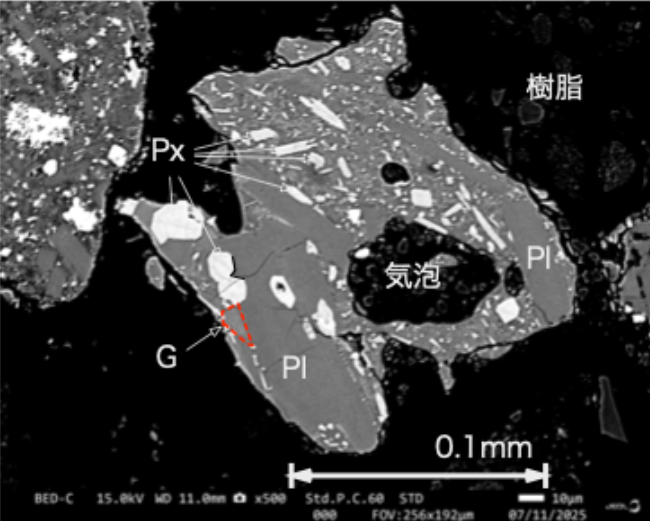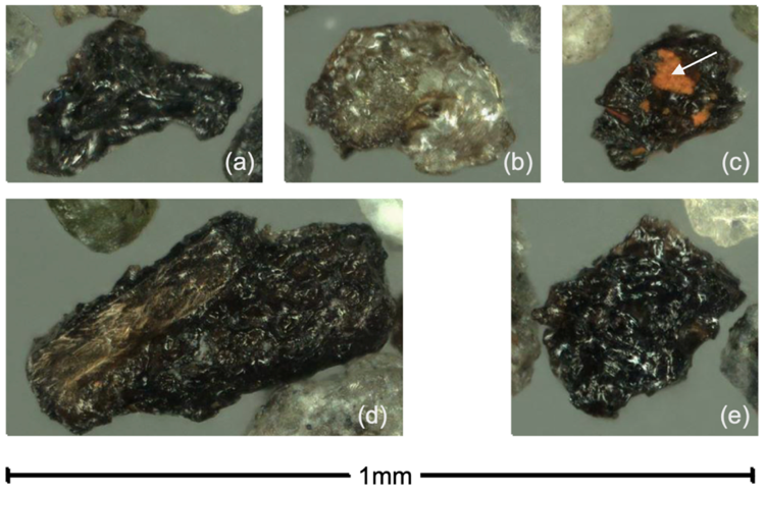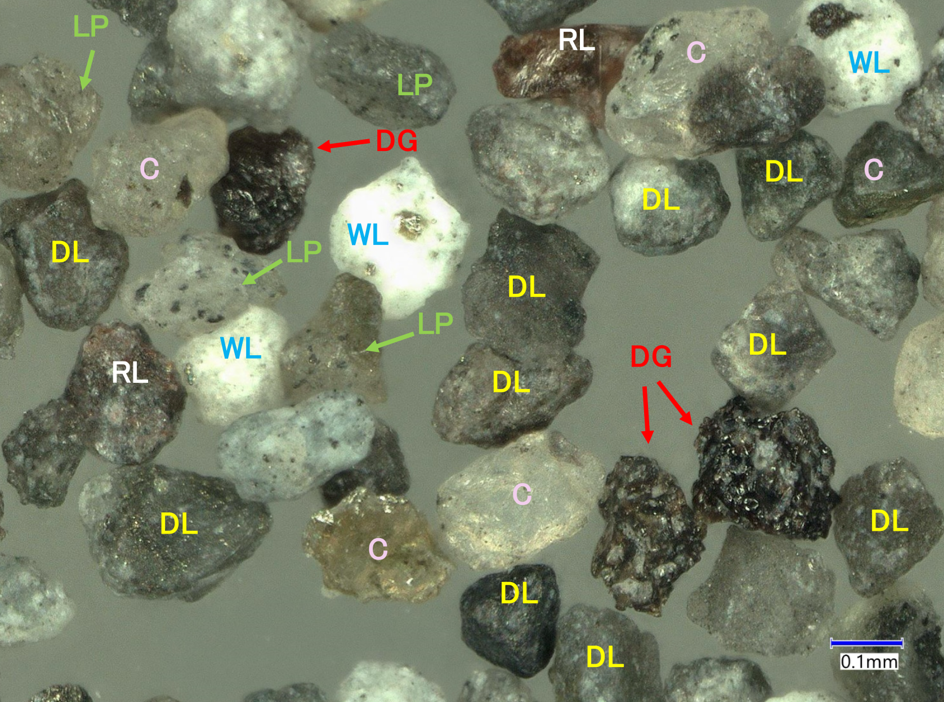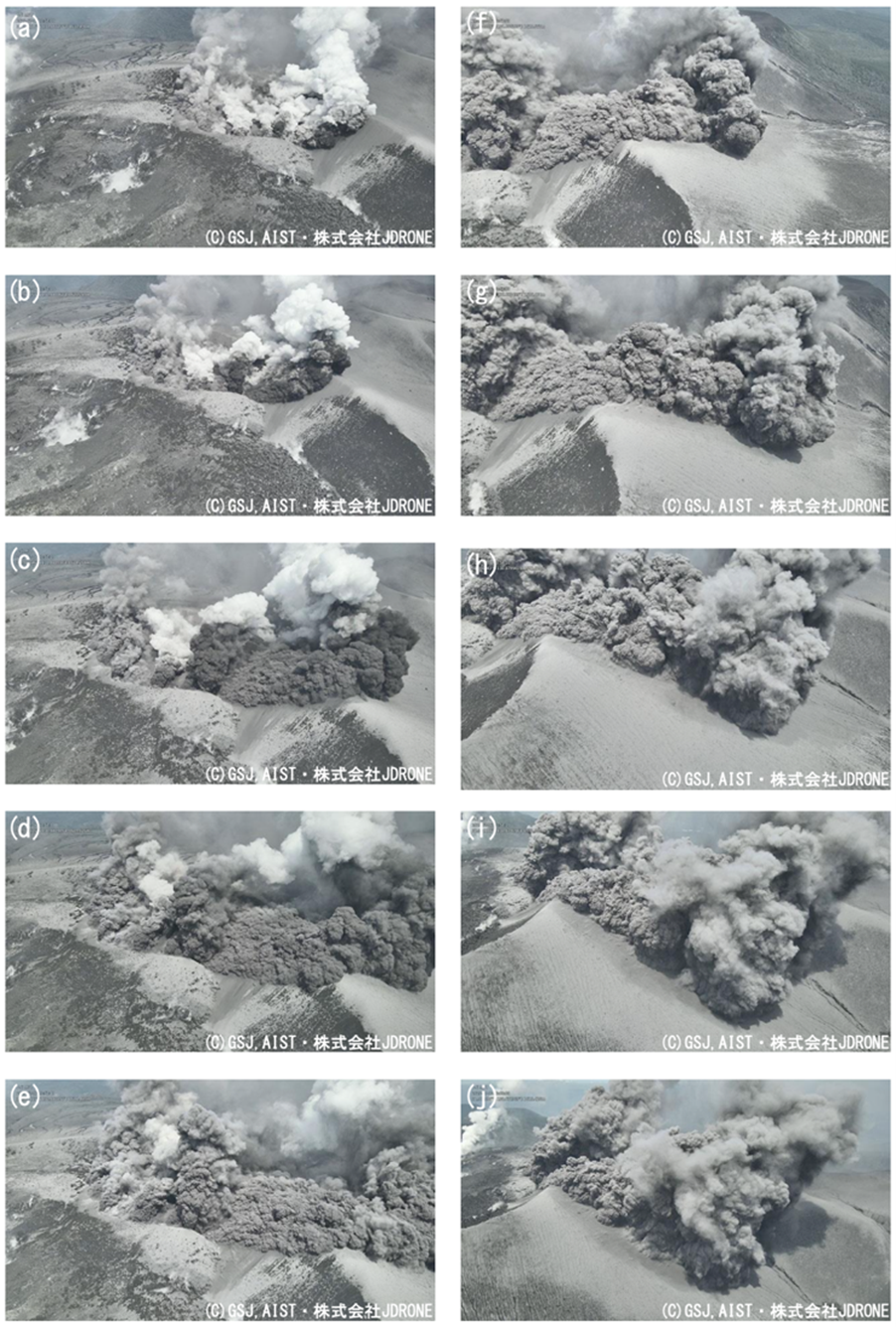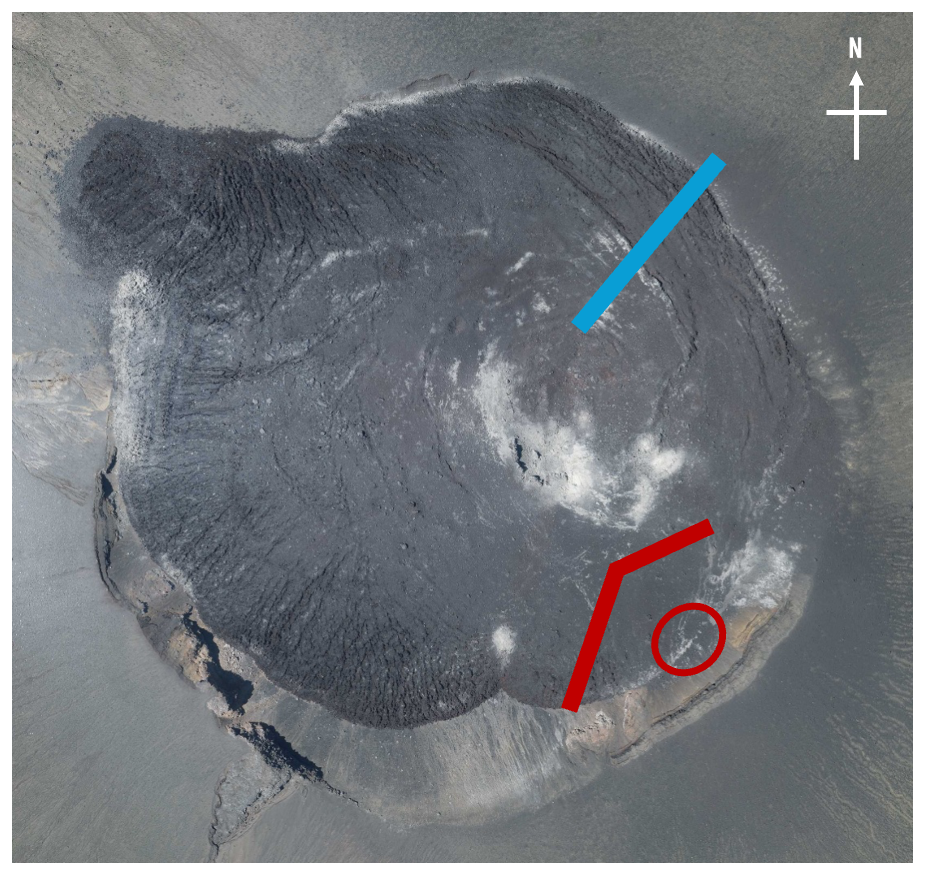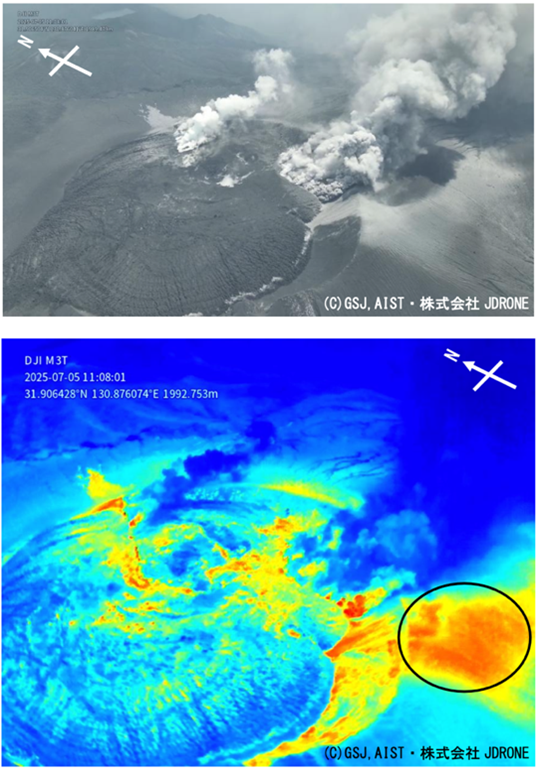Shinmoe-dake, Kirishima Volcano Group (2025)
Research Institute of Earthquake and Volcano Geology
Release date: July 25, 2025 (JST)
Survey results regarding the 2025 eruption of Shinmoe-dake, Kirishima
In response to the eruption of Shinmoe-dake within the Kirishima Volcano Group, which began on 22 June 2025, the Geological Survey of Japan (GSJ) of AIST promptly observed volcanic ash samples sent by the Japan Meteorological Agency and dispatched a field investigation team from 26 June.
As the eruption response survey progresses, the results of the investigation and analysis of the eruption will be reported to the Headquarters for Volcano Research Promotion and other organizations, and will be posted on this page. The investigation is being carried out in cooperation with the Japan Meteorological Agency, local parties, other research institutes, universities, etc. Please note that the content may be revised or changed as the investigation and research progresses.
The state of the crater photographed by a drone that was deployed to conduct volcanic gas measurements on 3 July. This photograph was taken from above the eastern side of Shinmoe-dake around 2 p.m., just after the plume rose to 5,000 m above the crater rim.
Summary of the eruption
On 22 June 2025, an eruption occurred at Shinmoe-dake for the first time in seven years since 27 June 2018, and has continued since then (as of 16 July). The number of earthquakes and the amount of volcanic gas released have been high during this period, so it is believed that the volcano remains active.
Component analysis of the ejecta
Chemical composition of minerals and glass in volcanic ash particles from the 2-4 July eruption (excerpt from documents submitted to the Headquarters for Volcano Research Promotion)
A small amount of shiny black to dark brown glass fragments (DG particles), which may have been derived from juvenile magma, were identified within the volcanic ash collected by AIST researchers during a field survey on 2-4 July. The particles appear glassy under an optical microscope; however, when observed and analyzed using an electron probe microanalyzer, abundant microlites were found to be present within the particles. In addition, the chemical composition of the minerals and glass contained in the particles was found to be almost the same as those within the ejecta from the A.D. 1716–2018 eruptions of Shinmoe-dake.
Backscattered electron image of a DG particle contained in volcanic ash collected on 2 July. Abbreviations are used for plagioclase (Pl), orthopyroxene (Px), and glass (G), which is highlighted in an area indicated by the red dotted line. DG particles have a fluidly elongated shape and appear glassy under an optical microscope, but cross-section observation with a scanning electron microscope revealed that such particles contain many microlites and only a small amount of glass.
Volcanic ash from the 2-4 July eruption (excerpt from documents submitted to the Headquarters for Volcano Research Promotion)
Based on observations of volcanic ash particles collected during a field survey by AIST researchers from 2-4 July, it was determined that the constituent particles were basically the same as those from the volcanic ash erupted from 22 June onwards, but on 2 July there was an increase in shiny black to dark brown glass fragments that may be derived from juvenile magma. The abundance of these glassy particles decreased on 3 and 4 July. In the future, it will be necessary to analyze particles that may be derived from juvenile magma and understand how the proportions of the constituent particles of the volcanic ash change over time.
Shiny black to dark brown glass fragments (DG) with vesicles found in the Shinmoe-dake volcanic ash collected on 2 July. (a): Has a fluidly elongated shape. (b): Contains plagioclase phenocrysts. (c): Contains red oxidized rock fragments (arrow). (d): Contains orthopyroxene phenocrysts. (e): A typical example of a DG particle found in the sample.
The ash grains of the 22 June 2025 ejecta (excerpt from documents submitted to the Headquarters for Volcano Research Promotion)
Samples collected by the Japan Meteorological Agency in Takaharu Town, Nishimorokata District on 22 June were sent to AIST, where they were analyzed under a microscope to determine the types and proportions of the constituent particles. Most of the particles within the erupted material are black and gray rock fragments, which are thought to originate from the lava that filled the crater of Shinmoe-dake from 2011 and 2018. Small amounts of white rock fragments and black and dark brown glass fragments filled with white material were also found, which are thought to originate from altered areas underground or nearby the volcano. It is important to continue to closely monitor the movements of Shinmoe-dake and observe any changes in the constituent particles of the eruption.
Microphotograph of volcanic ash particles collected by the Japan Meteorological Agency in Takaharu Town, Nishimorokata District, Miyazaki Prefecture on 22 June 2025. (For more details, see the document “Characteristics of volcanic ash particles from the Shinmoe-dake eruption on 22 June 2025” – in Japanese)
Field survey (preliminary observations)
In order to assess the ongoing scale of the eruption and track changes in the volcanic ejecta, the Geological Survey of Japan, AIST, has dispatched staff to Kirishima since 26 June to conduct surveys of the ash distribution and to collect samples of ejecta. The quantitative results of the fixed area amount of ash fall at each point will provide basic data for estimating the total amount of ash fall from the eruption. Additionally, volcanic gas observations were conducted using a drone from 3-7 July. The results showed that the volcanic gas emitted at the time of observation had characteristics indicative of interaction with groundwater and hydrothermal systems after being supplied by degassing magma. The location of new vents was also revealed by photographing the area around the crater using a drone, and an explosive eruption was also captured during the flight on 6 July.
Photographed on 6 July (Extracted from documents submitted to the Headquarters for Volcano Research Promotion)
The explosive eruption at around 13:57 on 6 July was observed by a drone (from above the southern rim of the summit crater). (a)-(j) Snapshots taken every 10 seconds from 13:57:00 to 13:58:30. A dark gray plume was emitted from the vent in the southeast part of the summit crater, from where it flowed sideways along the slope and then drifted upwards.
Photographed on 4-5 July (Excerpt from documents submitted to the Headquarters for Volcano Research Promotion
The location of new vents associated with the 2025 eruption estimated by photograph interpretation (blue line: line of vents that were active until 3 July; red line: line of vents that were newly formed on 4 July; red circle: location of new single vent). The basement satellite image sourced from GSI website (https://maps.gsi.go.jp/).
The state of the crater at around 11 a.m. on 5 July, observed by drone. A relatively high-temperature area (about 50℃ or higher) can be seen on the southern slope outside the crater (black circle). Top: visible image; bottom: thermal infrared image.
Note: “crater” refers to the area about 800 m in diameter that is filled with lava; “vent” refers to the localized eruption points from which plumes of ash and gas are emitted.
Photographed on 3 July
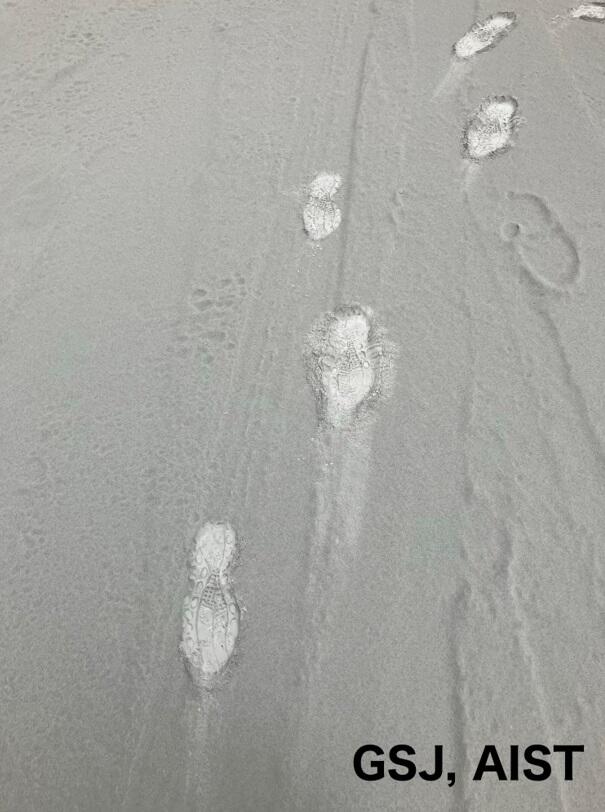 |
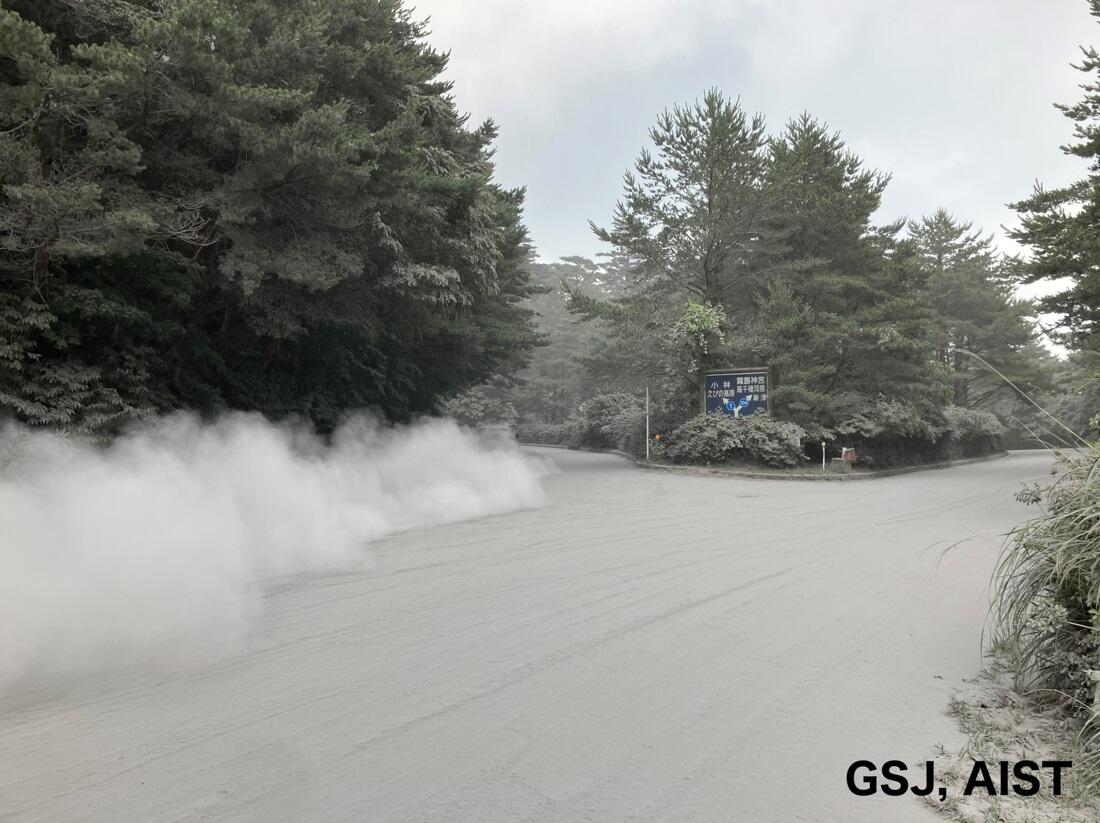 |
Ashfall at Shinyu intersection (around 4 p.m.)
Photographed on 26–28 June
Eruption plume from Shinmoe-dake. Photographed at around 17:37 on 28 June 2025.
Ash fall survey (26 June).
Ash fall at Takachiho-gawara (28 June).
Volcano Research Promotion Headquarters Materials
Materials submitted by AIST to the Volcano Research Promotion Headquarters have been made public (in Japanese).
- 2025年7月4-5日新燃岳での火山ガス観測結果(PDF, 1.3MB) 火山調査委員会:産業技術総合研究所・名古屋大学(2025.10.10.)
- 霧島山新燃岳2025年噴火の火山灰の特徴と化学組成(PDF, 3.3MB) 火山調査委員会(2025.10.10.)
- 新燃岳2025年噴火の火孔位置変化とイベントの様子(PDF, 1.2MB) 火山調査委員会(2025.10.10.)
- 新燃岳でのドローンによるアルカリフィルタ観測(PDF, 402KB)機動的な調査観測・解析グループ:産業技術総合研究所・京都大学・東京科学大学・九州大学・東京大学理学系研究科・東京大学地震研究所・防災科学技術研究所(2025.10.1.)
- ドローン調査(9月14日)による新燃岳(霧島山)の活動状況 速報(PDF, 1.4MB)機動的な調査観測・解析グループ:防災科学技術研究所・京都大学・東京科学大学・東京大学・九州大学・産業技術総合研究所(2025.9.30.)
- 新燃岳2025年9月3日噴火の火山灰構成粒子の特徴(PDF, 1.6MB)(2025.9.22.)
- 新燃岳2025年8月28日噴火の火山灰構成粒子の特徴(PDF, 2.8MB)(2025.9.4.)
- 新燃岳2025年8月10日噴火の火山灰構成粒子の特徴(PDF, 2.5MB)(2025.8.19.)
- 新燃岳2025年7月22日に採取された火山灰の構成粒子の特徴(PDF, 2.8MB)(2025.8.4.)
- 新燃岳2025年7月7日の火口状況(PDF, 7MB)(2025.7.30.)
- 新燃岳におけるマグマ水混合比および火山性流体温度構造推定結果 速報(PDF, 1.6MB):名古屋⼤学・産業技術総合研究所(2025.7.25.)
- 新燃岳2025年7月2〜4日噴火の火山灰構成粒子の鉱物・ガラス化学組成(PDF, 3.2MB)(2025.7.15)
- 新燃岳2025年7月5〜9日噴火の火山灰構成粒子の特徴(PDF, 8MB)(2025.7.14.)
- 新燃岳でのドローン+SelPSによるCO2同位体観測 速報(PDF, 641KB):名古屋⼤学・産業技術総合研究所(2025.7.14.)
- 新燃岳2025年7月4~6日噴火の火山灰構成粒子の特徴(PDF,6MB)(2025.7.10.)
- 新燃岳2025年7月2日〜4日の火山灰構成粒子の特徴(PDF,9MB)(2025.7.8.)
- 新燃岳でのドローンによるマルチガス観測(2025.7.5.) 速報(PDF, 233KB)(2025.7.8.)
- 新燃岳ドローン観測報告:7月6日の火口の状況と爆発的噴火発生の瞬間(速報)(PDF, 1.2MB)(2025.7.8.)
- 新燃岳における新たな火孔列の形成(続報)(PDF, 1MB)(2025.7.7.)
- 新燃岳における新たな火孔列の形成(速報)(PDF, 3.7MB)(2025.7.7.)
- 新燃岳2025年6月26~28日噴火の火山灰構成粒子の特徴(PDF, 6MB)(2025.7.3.)
- 新燃岳2025年6月26日噴火の火山灰構成粒子の特徴(PDF, 779KB)(2025.7.2.)
- 新燃岳2025年6月22日噴火の火山灰構成粒子の特徴(PDF, 3.5MB)(2025.6.27.)
Related Information
The Geological Survey of Japan, AIST, provides the following related information on Kirishima Volcano:
- Kirishima Yama (Volcanoes of Japan > Quaternary Volcanoes database) (in English)
- Kirishima Yama (Volcanoes of Japan > Active Volcanoes database) (in English)
- Survey results regarding the 2018 eruption of Shinmoe-dake, Kirishima (in Japanese)
- Survey results regarding the 2017 eruption of Shinmoe-dake, Kirishima (in Japanese)
- Survey results regarding the 2011 eruption of Shinmoe-dake, Kirishima (in Japanese)
- Survey results regarding the 2008 eruption of Shinmoe-dake, Kirishima (in Japanese)
Updates
- 2025.10.10: "Volcano Research Promotion Headquarters Materials" updated.
- 2025.10.1: "Volcano Research Promotion Headquarters Materials" updated.
- 2025.9.30: "Volcano Research Promotion Headquarters Materials" updated.
- 2025.9.22: "Volcano Research Promotion Headquarters Materials" updated.
- 2025.9.4: "Volcano Research Promotion Headquarters Materials" updated.
- 2025.8.19: "Volcano Research Promotion Headquarters Materials" updated.
- 2025.8.4: "Volcano Research Promotion Headquarters Materials" updated.
- 2025.7.30: "Volcano Research Promotion Headquarters Materials" updated.
- 2025.7.25: "Volcano Research Promotion Headquarters Materials" updated.
- 2025.7.24: The image of "The location of new vents associated with the 2025 eruption estimated by photograph interpretation" has been replaced due to copyright considerations.
- 2025.7.17: released
IEVG (Research Institute of Earthquake and Volcano Geology)



